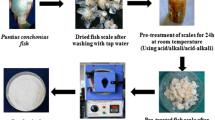Abstract
Fish scales are natural sources of collagen and hydroxyapatite, yet are typically considered waste. In this study, fish scale powder obtained from Tilapia fish (Oreochromis mossambicus) was used to synthesize scaffolds by freeze casting for the removal of lead ions from wastewater. The mineral hydroxyapatite was confirmed by x-ray diffraction. Scaffolds with a well-aligned lamellar microstructure (10–80-μm channel widths) and proper mechanical properties under compression were synthesized by controlling the solid loading, cooling rate, and sintering temperature. The maximum adsorption capacities (q max) were 208.3 mg/g and 344.8 mg/g in pH = 5 and pH = 2.2 solutions, respectively. More than 99.9% of the lead ion was removed after 20 min. The results show that fish-scale-derived hydroxyapatite scaffolds are promising for heavy metal ion removal and wastewater treatments.




Similar content being viewed by others
References
S. Davydova, Microchem. J. 79, 133 (2005).
S.E. Bailey, T.J. Olin, R.M. Bricka, and D.D. Adrian, Water Res. 33, 2469 (1999).
C.T. Benatti, C.R. Tavares, and E. Lenzi, J. Environ. Manage. 90, 504 (2009).
L. Cui, L. Hu, X. Guo, Y. Zhang, Y. Wang, Q. Wei, and B. Du, J. Mol. Liq. 198, 157 (2014).
R. Donat, A. Akdogan, E. Erdem, H. Cetisli, and J. Colloid, Interface Sci. 286, 43 (2005).
H. Xu, L. Yang, P. Wang, Y. Liu, and M. Peng, J. Environ. Manag. 86, 319 (2008).
J.W. Shen, T. Wu, Q. Wang, and H.H. Pan, Biomaterials 29, 513 (2008).
Y. Takeuchi, T. Suzuki, and H. Arai, J. Chem. Eng. Jpn. 21, 98 (1988).
Q.Y. Ma, S.J. Traina, T.J. Logan, and J.A. Ryan, Environ. Sci. Technol. 27, 1803 (1993).
Y. Feng, J.-L. Gong, G.-M. Zeng, Q.-Y. Niu, H.-Y. Zhang, C.-G. Niu, J.-H. Deng, and M. Yan, Chem. Eng. J. 162, 487 (2010).
M. Ferraz, F. Monteiro, and C. Manuel, J. Appl. Biomater. Biomech. 2, 74 (2004).
X. Zhang and K.S. Vecchio, J. Cryst. Growth 308, 133 (2007).
D.-M. Liu, T. Troczynski, and W.J. Tseng, Biomaterials 22, 1721 (2001).
S. Mondal, B. Mondal, A. Dey, and S.S. Mukhopadhyay, J. Miner. Mater. Charact. Eng. 11, 55 (2012).
Y.-C. Huang, P.-C. Hsiao, and H.-J. Chai, Ceram. Int. 37, 1825 (2011).
Y. Lei, W. Chen, B. Lu, Q.-F. Ke, and Y.-P. Guo, RSC Adv. 5, 98783 (2015).
H. Zhang, I. Hussain, M. Brust, M.F. Butler, S.P. Rannard, and A.I. Cooper, Nat. Mater. 4, 787 (2005).
S. Deville, E. Saiz, and A.P. Tomsia, Biomaterials 27, 5480 (2006).
U.G. Wegst, M. Schecter, A.E. Donius, and P.M. Hunger, Philos. Trans. A. Math. Phys. Eng. Sci. 368, 2099 (2010).
M.M. Porter, J. McKittrick, and M.A. Meyers, JOM 65, 720 (2013).
S. Mondal, S. Mahata, S. Kundu, and B. Mondal, Adv. Appl. Ceram. 109, 234 (2010).
Acknowledgements
This study is supported by the Ministry of Science and Technology, Taiwan (MOST103-2221-E-007-034-MY3).
Author information
Authors and Affiliations
Corresponding author
Electronic supplementary material
Below is the link to the electronic supplementary material.
Rights and permissions
About this article
Cite this article
Liu, WK., Liaw, BS., Chang, HK. et al. From Waste to Health: Synthesis of Hydroxyapatite Scaffolds From Fish Scales for Lead Ion Removal. JOM 69, 713–718 (2017). https://doi.org/10.1007/s11837-017-2270-5
Received:
Accepted:
Published:
Issue Date:
DOI: https://doi.org/10.1007/s11837-017-2270-5




